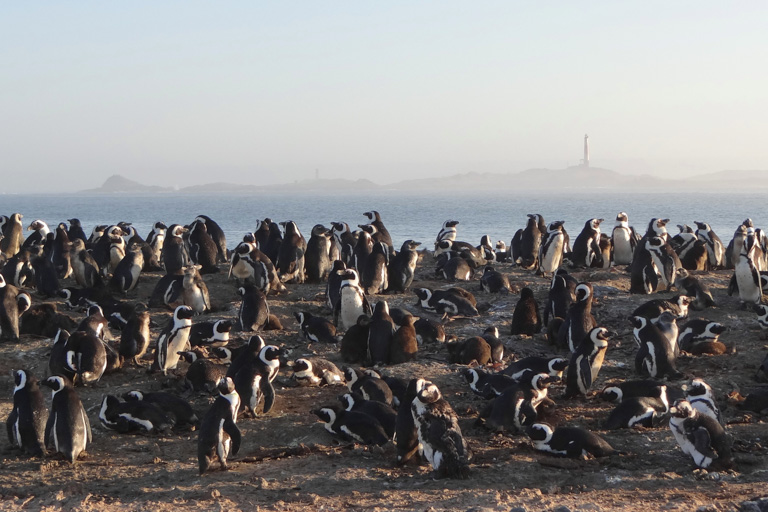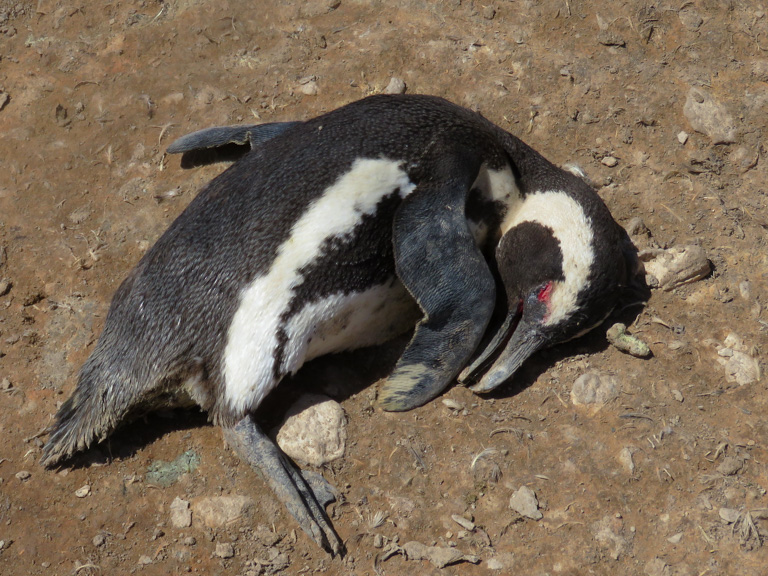- More than 450 African penguins, an IUCN-listed endangered animal, have died in an outbreak of bird flu on three islands off the coast of Namibia.
- The virus, H5N8, is thought to have been introduced to the colonies, which hold 96 percent of Namibia’s penguins, by another bird traveling from South Africa, where a similar outbreak occurred in 2018.
- The disease appears to be abating, and researchers are hopeful that the country’s penguins will recover.
- However, they continue to face threats from food shortages caused by overfishing and climate change.
For more than three months, penguins living off the coast of Namibia have been battling an outbreak of bird flu. The worst of the disease seems to have passed, but hundreds of birds have died, said Jessica Kemper, an independent conservation biologist in Lüderitz, Namibia.
“We might still get some mortalities, but hopefully the epidemic will be over in the next few weeks,” Kemper told Mongabay by email. “Luckily the virus didn’t go completely wild, and unless it flares up again or another potentially catastrophic event takes place (think oil spill), the population should recover.”

Namibia’s fisheries ministry alerted the public to the outbreak on Feb. 13. By mid-April, the virus had killed at least 459 penguins on the islands of Halifax, Ichaboe and Mercury off the coast of southwestern Namibia. More may have died, their carcasses washing out to sea before scientists could count them. Kemper and her colleagues have been burning the bodies of penguins killed by the H5N8 bird flu virus. It’s a safety measure to keep the virus from spreading, she said, learned from biologists in Cape Town, South Africa, who faced a similar bout of avian flu in 2018.
Treatment is not a viable option, as the disease progresses quickly once the penguins start to look sick before sinking into a coma, Kemper said. In fact, releasing birds that have recovered may help the virus maintain its foothold in the colony.
“It’s hard not to be able to help the birds, but I can understand that there’s no point saving a few individuals who then have the potential to spread the disease,” Kemper said.

H5N8 poses little threat to humans, as recent scientific research confirms.
“I guess I’m living proof of that. It took us several weeks to figure out what is causing these penguin deaths, and I ended up handling sick birds for several weeks,” Kemper said, adding that she’d taken the precautions of wearing gloves and oilskins while in contact with the penguins.
But it is “highly contagious” to other birds, she added, and suggested that perhaps a gannet or a tern or another penguin, may have traveled from a colony in Cape Town affected by the disease in 2018 and brought the virus to Halifax.

“Bird flu outbreaks in wild animals, in particular in aquatic birds [are] very rare,” Umberto Molini, a veterinarian and senior lecturer in the pathobiology department at the University of Namibia, said in an email. Wild birds are more often carriers of the disease, he added. Molini is currently working to see if the virus is the same strain of H5N8 that infected the colony in South Africa.
The disease can also devastate domestic poultry, killing up to 90 percent of birds in an afflicted population, he said.
“Luckily the islands are far away from the nearest poultry farm, and so far it seems to have been contained to the islands and to the penguins,” Kemper said.

African penguins (Spheniscus demersus), found only in South Africa and Namibia, are considered endangered by the IUCN and critically endangered by the Namibian government. As numbers of sardines on which they depend bottomed out as a result of heavy fishing in the 1960s, so did the penguins. When Kemper began working on Halifax Island in 1999, some 450 breeding pairs lived there, down from tens of thousands that once waddled the island.
Halifax, which together with the birds living on Ichaboe and Mercury islands accounts for 96 percent of Namibia’s penguin population, was home to 1,400 penguin breeding pairs at last count in 2018. Photographer Thomas Peschak captured the difference on Halifax Island in side-by-side photographs, one from the 1890s and the other from 2017.
“Losing 400-500 penguin on this island therefore will knock the local population back,” Kemper said. By itself though, it’s a threat that Namibia’s African penguins are likely to survive. But they face a far different world than what existed a century or even a few decades ago: Cumulative shocks from disease and food shortages caused by climate change and overfishing could be insurmountable for the species.

Fishing pressure hasn’t allowed the sardines to recover, despite the rich plankton that surf the Benguela Current coming up the coast of Namibia from Antarctica. And recent modeling of the southern Benguela system found that warmer temperatures would likely diminish the biomass of many types of marine life attracted by the upwelling of nutrients in this part of the Atlantic Ocean, from zooplankton on up to whales, seabirds and seals. The results, published in the journal Fisheries Oceanography in 2018, indicate that forage fish such as sardines, herring and anchovies — a critical food source for many animals including penguins — are likely to be among the hardest hit.
Sardine numbers have continued to lag, so the Namibian government halted the country’s commercial sardine fishery for three years in 2017. Kemper said it’s a step toward allowing sardine numbers to recover, though more needs to be done.

“In my mind three years are not enough to turn around a desperately depleted sardine stock,” Kemper said.
“After all, the sardine is the KEY to the healthy functioning of the Benguela marine ecosystem,” she added. “Take out the sardine and the whole system falls apart. Which is exactly what we are seeing. It goes much further than the state of the penguin population.”
Banner image of African penguins on Halifax Island © Jessica Kemper.
John Cannon is a Mongabay staff writer based in the Middle East. Find him on Twitter: @johnccannon
Citations
BirdLife International. (2018). Spheniscus demersus. The IUCN Red List of Threatened Species2018: e.T22697810A132604504. doi:10.2305/IUCN.UK.2018-2.RLTS.T22697810A132604504.en. Downloaded on 23 April 2019.
Tate, M. D. (2018). Highly pathogenic avian H5N8 influenza viruses: should we be concerned? Virulence, 9(1), 20–21. doi:10.1080/21505594.2017.1386832
Ortega‐Cisneros, K., Cochrane, K. L., Fulton, E. A., Gorton, R., & Popova, E. (2018). Evaluating the effects of climate change in the southern Benguela upwelling system using the Atlantis modelling framework. Fisheries Oceanography, 27(5), 489-503. doi:10.1111/fog.12268
FEEDBACK: Use this form to send a message to the author of this post. If you want to post a public comment, you can do that at the bottom of the page.
This story first appeared on Mongabay
South Africa Today – Environment
This article is licensed under a Creative Commons Attribution-NoDerivatives 4.0 International License.
You may republish this article, so long as you credit the authors and Mongabay, and do not change the text. Please include a link back to the original article.











